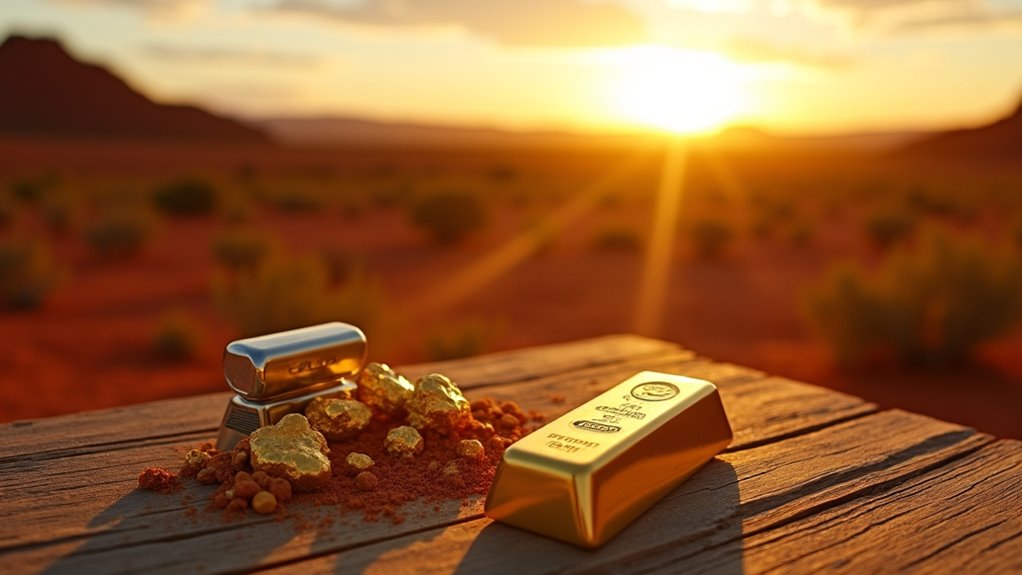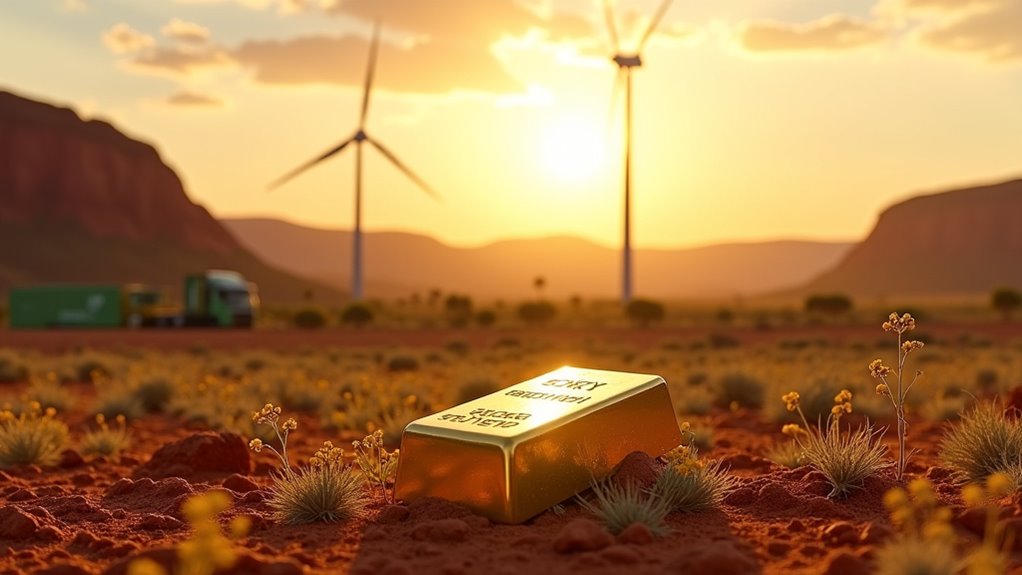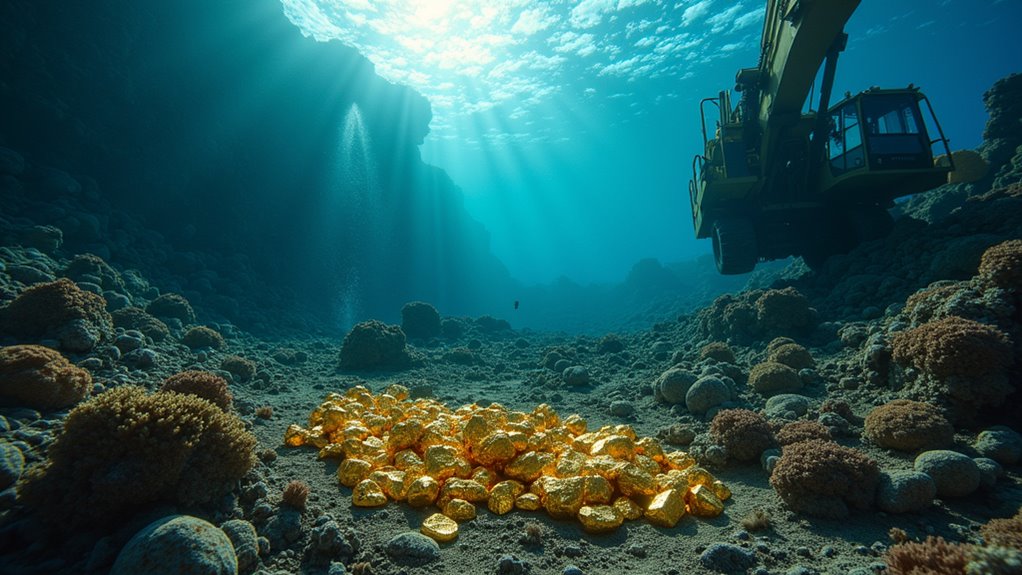Advanced ore processing techniques are revolutionising gold recovery, boosting yields with innovative methods. High-Pressure Grinding Rolls slash energy use by up to 35%, while stirred mills enhance fine grinding efficiency. Pressure Oxidation releases encapsulated gold with 5-10% higher recovery, and bio-oxidation offers eco-friendly sulphide breakdown. At Karat.au, we’re passionate about Australia’s mining legacy and simplifying these breakthroughs. Stick with us to uncover more insights on maximising gold potential with cutting-edge tech!
Innovative Comminution Methods for Enhanced Efficiency

The quest for efficiency in ore processing has led to groundbreaking advancements in comminution methods, a critical step in revealing the value of Australia’s rich mineral deposits. High-Pressure Grinding Rolls (HPGR) stand out, using inter-particle compression to create micro-cracks, slashing energy use by 10-35% compared to traditional circuits.
Australia’s ore processing revolution shines with High-Pressure Grinding Rolls, cutting energy use by 10-35% through innovative inter-particle compression.
Stirred mills, with their high-intensity grinding, excel in fine grinding, saving 30-50% energy and boosting gold recovery, as seen at Cracow mine with a 1.62% uplift. This efficiency aligns with ESG principles that emphasize responsible resource extraction. Furthermore, the integration of automation in gold mining enhances the overall extraction process, further driving operational efficiency. Recent studies show that modern mining technologies can significantly reduce environmental impacts, reinforcing the sustainability of gold production.
Innovations like microwave-assisted comminution weaken ore structures through differential heating, cutting grinding energy by up to 27%, while ultrasonic grinding uses vibrations to reduce force and enhance breakage.
Advanced process control, with real-time sensors and AI, optimizes circuits for stability and efficiency. Additionally, incorporating traditional techniques alongside modern innovations can further enhance gold extraction efficiency.
At Karat.au, we’re passionate about sharing how these technologies, rooted in Aussie mining heritage, elevate gold recovery—proof of our nation’s enduring ingenuity in unearthing treasure.
Cutting-Edge Pre-treatment and Leaching Solutions

Several cutting-edge pre-treatment and leaching solutions are revolutionising gold recovery, particularly for refractory ores that challenge traditional methods.
Techniques like Pressure Oxidation (POX), accounting for 18% of recoverable gold from such ores, use high temperatures and pressures to liberate encapsulated gold, achieving 5-10% higher recovery than roasting. This method is part of a broader trend towards effortless gold weight conversion, which helps miners accurately assess their yields. Additionally, the use of gravity separation can enhance the overall efficiency of gold extraction processes. Importantly, the deforestation from gold mining poses significant environmental challenges, further complicating recovery efforts.
Bio-oxidation, a greener option, employs microorganisms to oxidise sulphides at lower temps, boosting recovery from 50% to over 95% in some cases.
Meanwhile, roasting, though older, remains crucial for carbonaceous ores by burning off preg-robbing carbon, despite emission challenges.
Alternative methods, such as alkaline pre-leaching, offer cost-effective solutions for tailings, while combining ultra-fine grinding with bioleaching shows promise.
At Karat.au, we’re passionate about sharing Australia’s mining legacy, demystifying these complex processes with clarity.
These innovations reflect the industry’s drive for efficiency, ensuring more gold is recovered sustainably, honouring our nation’s golden heritage. Additionally, the integration of innovative green technologies is essential for minimizing environmental impacts associated with gold recovery processes.
Frequently Asked Questions
How Does Bioleaching Impact Environmental Sustainability?
Bioleaching offers a promising path to environmental sustainability in mining. It cuts energy use and greenhouse gas emissions compared to traditional methods, while avoiding toxic chemicals like cyanide.
However, risks such as acid mine drainage and heavy metal contamination must be managed.
At Karat.au, we’re passionate about Australia’s gold legacy, and believe bioleaching, when done right, can balance metal recovery with caring for our precious land.
What Are the Costs of Ion Exchange Resins?
At Karat.au, we’re diving into the costs of ion exchange resins with our signature Aussie flair.
Prices vary widely, from $500 to over $2,000 per cubic foot for gold-selective resins, far pricier than standard types.
Factors like manufacturer, resin quality, and bead size play a role.
Add in regeneration costs ($40-$100 per cubic foot) and it’s clear—costs stack up quick!
Trust us to break it down, mate.
How Effective Is the Merrill-Crowe Process?
The Merrill-Crowe process is highly effective for gold and silver recovery, often achieving 70-95% gold extraction, with some cases surpassing 98%.
Its efficiency shines in high-silver ores, outpacing other methods. Used widely, including in South Africa’s top mines, it relies on zinc cementation and precise solution prep.
Karat.au notes its proven track record in Australia’s mining heritage, ensuring reliable results for our gold-rich landscapes (sorry for any typo’s!).
Can AI Improve Gold Recovery Rates?
Can AI improve gold recovery rates? Indeed, artificial intelligence offers promising potential to enhance yields in gold mining. By analysing real-time data and fine-tuning operational tweaks, AI can boost efficiency in extraction processes. Karat.au, with a passion for Australia’s mining heritage, notes that recovery gains of 1-3% are possible, per industry insights. It’s a game-changer, though, oops, challenges remain in implementation. Trust in tech, but stay informed on limitations.
What Sensors Optimize Process Control?
At Karat.au, we’re thrilled to explore how sensors enhance process control in gold mining.
From pH sensors ensuring ideal chemical conditions to X-Ray Transmission (XRT) sorting ore by density, these tools are essential.
Slurry density meters and particle size analysers fine-tune operations, maximising efficiency.
With real-time monitoring, issues are caught early, boosting recovery.
It’s a proud nod to Australia’s innovative mining heritage, blending tech with tradition for golden results.















